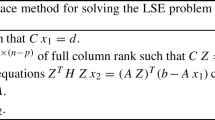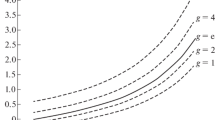Abstract
A method is described for reducing the solution of a matrix equation of linear equations, Mz = d, to that of a number of simpler equations. The method is one mathematical version of diakoptics, and can be used to solve engineering problems involving linear equations without specialization to each individual application. The method has the usual advantages of diakoptics: different parts of the problem can be solved on different computers (distributed computation), decreased computer storage requirements in fast storage, applicability to some types of parallel processors and decreased computation time in some circumstances. Consideration is given to reducing M to specific forms including block triangular, banded and the usual block diagonal. Consideration is also given to the case where M is not square and a new application is given to solving least-squares problems.
Similar content being viewed by others
References
P.W. Aitchison: Diakoptics or tearing — a mathematical approach, Quarterly of Applied Mathematics 41 (1983) 265–272.
H. Asai and M. Tanaka: Diakoptics: multi-level tearing method and estimation of the computation time, Proceedings of International Symposium on Circuits and Systems, 1984, Vol. 1, IEEE, New York (1984) 364–367.
Adi Ben-Israel and T.N.E. Greville: Generalized Inverses: Theory and Applications, Wiley, New York (1974), reprinted by Krieger (1980).
M.V. Bhat and H.K. Kesaven: Diakoptic equations and sparsity, IEEE PES Summer Meeting, Anaheim (1974); IEEE (1974) paper C74.384-4.
M.D. Bradshaw: An electromagnetic analog to the method of diakoptics (Kron's ‘tearing technique’) of circuit analysis, 23rd. Midwest Symposium on Circuits and Systems, Toledo (1980) 562–566.
A. Brameller, M.N. John and M.R. Scott: Practical Diakoptics for Electrical Networks, Chapman and Hall, London (1969).
A. Brameller and K.L. Lo: The application of diakoptics and the escalator method to the solution of very large eigenvalue problems, International journal for Numerical Methods in Engineering 2 (1970) 535–549.
H.F. Bückner: Numerical methods for integral equations; in: Survey of Numerical Analysis, McGraw-Hill, New York (1962).
J.R. Bunch and D.J. Rose: Partitioning, tearing and modification of sparse linear systems, Journal of Mathematical Analysis and Applications 48 (1974) 574–593.
G. Cafaro, P. Pugliese and F. Vacca: Parallel solution of turn networks, International Journal of Electrical Power and Energy Systems 6 (1984) 131–138.
C.F. Chen and K.U. Wang: Diakoptics for eigenvalues of large scale networks, 23rd Midwest Symposium on Circuits and Systems, Toledo (1980); North Holland, California (1980) 572–574.
L.O. Chua and L. Chen: Diakoptic and generalized hybrid analysis, IEEE Transactions on Circuits and Systems 23 (1976) 694–705.
J. Constantinescu: Study of the transient processes in large-scale power systems, Revue Roumaine des Sciences Techniques (Serie d'Electrotechnique et Energetique) 27 (1982) 211–227.
P. Cristea and M. Iordache: A diakoptic analysis method, IEEE International Symposium on Circuits and Systems (1983), IEEE, New York (1983) 633–636.
I.S. Duff and J.K. Reid: An implementation of Tarjan's algorithm for the block triangularization of a matrix, ACM Transactions on Mathematical Software 4 (1978) 137–147 and 189–192.
M. El-Marsafawy, R.W. Menzies and R.M. Mathur: New diakoptic technique for load-flow solution of very large power-systems using the bus admittance matrix, Proc. Institution of Electrical Engineers 126 (1979) 1301–1302.
T. Tukao and E. Teratsuji: An extension of diakoptics and its application to singular decomposition problem of networks, Electrical Engineering in Japan 102 (1) (1982) 141–148.
A. George and J.W. Liu: Computer Solution of Large Sparse Positive Definite Systems, Prentice Hall, New Jersey (1981) Ch. 4
N.E. Gibbs, W.G. Poole and P.K. Stockmeyer: An algorithm for reducing the band width and profile of a sparse matrix, SIAM Journal of Numerical Analysis 13 (1976) 236–250.
G. Goubao, N.N. Puri and F.K. Schwering: Diakoptic theory for multi-element antennas, IEEE Transactions on Antennas and Propagation 30 (1982) 15–26.
I.N. Hajj: Diakoptics and block elimination, IEEE 1978 Summer Power Meeting at Los Angeles, paper A78, 564–7.
I.N. Hajj: Sparsity considerations in network solution by tearing, IEEE Transactions on Circuits and Systems 27 (1980) 357–366.
H.H. Happ: The Application of diakoptics to the solution of power system problems, in: Electrical Power Problems, The Mathematical Challenge, SIAM (1980) 69–103.
H.H. Happ: Piecewise Methods and Applications to Power Systems, John Wiley, Chichester (1980).
H.V. Henderson and S.R. Searle: On deriving the inverse of a sum of matrices, SIAM Review 23 (1981) 53–60.
P. Henrici: Discrete Variable Methods in Ordinary Differential Equations, John Wiley, New York (1962).
P.B. Johns and K. Akhtarzad: Time domain approximations in the solution of fields by time domain diakoptics, International Journal for Numerical Methods in Engineering 18 (1982) 1361–1373.
H.K. Kesaven and J. Dueckman: Multi-terminal representations and diakoptics, Journal of the Franklin Institute 313 (1982) 337–352.
A. Klos: What is diakoptics? Electrical Power and Energy Systems 4 (1982) 192–195.
I.N. Kotarova and O.Yu. Shamaeva: A parallel diakoptics method of solving complex problems on distributed computational systems, Cybernetics 15 (1979) 131–141.
G. Kron: Diakoptics — piecewise solution of large scale systems, The Electrical Journal, in 20 parts from 158 (1957) 1673–1677 to 162 (1959) 431–436.
B. Majundar and T.N. Saha: Diakoptic approach to symmetrical short circuit analysis, Journal of the Institution of Engineers (India), part EL, Electrical Engineering Division 61 (1980) 1–4.
S.Y. Mansour, D.H. Kelly and D.O. Koval: Diakoptical active-reactive dispatch of generation, Proceedings of the 1984 IEEE International Symposium on Circuits and Systems, Vol. 1, IEEE, New York (1984) 136–139.
O.W. Marcus, K. Reiss, B.X. Weis and Z.P. Tomaszewski: Basic considerations on an adaptive iteration algorithm for large scale network analysis, Proceedings of the 1983 IEEE Symposium on Circuits and Systems, Vol. 1, IEEE, New York (1983) 230–233.
J. Myslik: Diakoptical analysis of the networks considering the changes of branch impedances, Electrotech. Obz. (Czechoslovakia) 73 (1984) 196–2000.
W.H. Press, B.P. Flannery, S.A. Teukolsky and W.T. Vetterling: Numerical Recipes: the Art of Scientific Computing, Cambridge University Press, Cambridge (1986).
N.B. Rabatt and H.Y. Hsieh: A latent macromodular approach to large-scale sparse networks, IEEE Transactions on Circuits and Systems 23 (1976) 745–752.
J.K. Reid: A survey of sparse matrix computation, in: Electrical Power Problems: the Mathematical Challenge, SIAM (1980) 41–68.
A. Sangiovanni-Vincentelli, L. Chen and L.O. Chua: A new tearing approach-node tearing nodal analysis, Proceedings of 1977 IEEE International Symposium on Circuits and Systems, IEEE, New York (1977) 143–147.
D.V. Steward: Partitioning and tearing of systems of equations, SIAM J. Numerical Analysis, Series B, 2 (1965) 345–365.
P.K.U. Wang and C.F. Chen: Sensitivity calculation and network optimization through decomposition, Proceedings of 1983 IEEE Symposium on Circuits and Systems, Vol. 3, IEEE, New York, (1983) 1034–1037.
F.F. Wu: Solution of large-scale networks by tearing, IEEE Transactions on Circuits and Systems 23 (1976) 706–713.
Author information
Authors and Affiliations
Rights and permissions
About this article
Cite this article
Aitchison, P.W. Diakoptics as a general approach in engineering. J Eng Math 21, 47–58 (1987). https://doi.org/10.1007/BF00127693
Received:
Accepted:
Issue Date:
DOI: https://doi.org/10.1007/BF00127693




